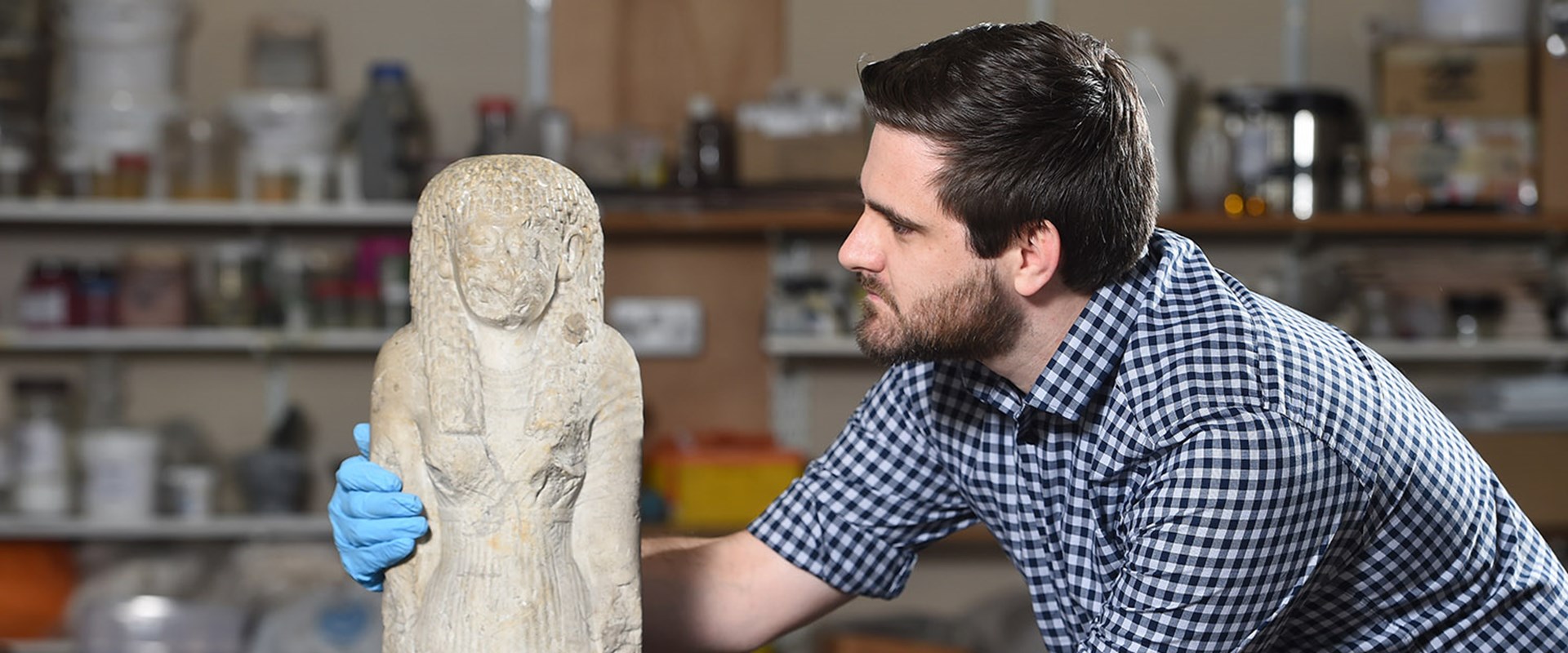#AncientEgyptTour
The subject of an important ancient Egyptian statue held in the collections of Montrose Museum has been identified thanks to a National Museums Scotland review of ancient Egyptian and East Asian collections held in local museums.
The limestone statue has been at Montrose Museum since 1837, but little was known about its provenance or its subject until now. During the review, the object was identified by curators as being an exquisite example of Ptolemaic (c.332–30 BC) statuary depicting a non-royal individual.
It will be displayed in Discovering Ancient Egypt, a touring exhibition from National Museums Scotland which opens at Montrose Museum on 7 June. The exhibition brings together fascinating objects and hidden stories from the collections of National Museums Scotland and each of the three touring venues to reveal how ancient Egypt has captivated Scotland over the past 200 years, as it still does today.
It was donated to the newly formed museum in 1837 by Montrose-born Dr James Burnes, a relative of the poet Robert Burns, who worked as the physician general for Bombay (Mumbai). After being sent on sick leave suffering from malaria, he travelled home to Scotland via Egypt in 1834 and collected the statue during his visit.
It depicts a female temple musician called Meramuniotes, who lived between 332-30 BC. The back of the statue is inscribed with a long, hieroglyphic text which has been fully translated for the first time. It discusses her family, her role in the temple and her wishes for the afterlife.
Her parents, siblings and descendants were all involved in the temple priesthood of ancient Thebes, and the inscription tells us that she played the sistrum – a percussion instrument - in the temple of Amun-Ra. Her mother, Nehemesratawy, held this same role, and they may even have worked together. Statues commemorating other members of her family can be found in museums in Cairo, Turin and London.
Dr Daniel Potter, Assistant Curator, Revealing Cultures Project at National Museums Scotland said:
“This statue is one of the finest of its type in the UK. Not only it is beautifully carved but it shares an amazing connection with Montrose. Until recently, rather little was known about it. Now, by working with our colleagues at Montrose Museum to explore their collections, we have been able to reveal some of the secrets of this remarkable object. Through this work, we have established how unique the statue is, and to put a name to the person it depicts and learn more about her and her relatives. It is a wonderful chance to connect with a family from over 2,000 years ago.”
The Discovering Ancient Egypt touring exhibition examines Scotland’s contribution to Egyptology through the lives of three remarkable people whose work in the field helped to improve our understanding of ancient Egyptian culture; Alexander Henry Rhind (1833-1863), Annie Pirie Quibell (1862-1927) and Charles Piazzi Smyth (1819-1900). An archaeologist, artist and astronomer, their skill, dedication and enthusiasm ensured that they each made a significant contribution to the study of ancient Egypt.
ANGUSalive has received funding from Museums Galleries Scotland, Montrose Heritage Trust and a private donor to display the statue of Meramuniotes in a new display case, allowing visitors to have a 360° view of it. The display and the story of Dr James Burnes will form the centrepiece of Montrose Museum's contribution to Discovering Ancient Egypt. National Museums Scotland are working with them to create engaging interpretation for the statue’s permanent display.
Caroline Taylor, Museum Officer at Montrose Museum, said:
”We are delighted that we will have the chance to showcase the statue of Meramuniotes and highlight her story, as well as how the statue was brought to Montrose, in an engaging way for our visitors.”
The national programme of activity focused on ancient Egypt and East Asia follows the success of the February 2019 opening of three new, permanent galleries at the National Museum of Scotland dedicated to Ancient Egypt, East Asia and the Art of Ceramics. The opening of these galleries marked the completion of the £80m, 15-year project to transform the Victorian building, reveal its remarkable treasures and create inspiring learning experiences to engage more visitors.
The Discovering Ancient Egypt tour is part of an innovative national programme which is funded by The National Lottery Heritage Fund and led by National Museums Scotland. It extends the reach and impact of the Ancient Egypt Rediscovered and Exploring East Asia galleries beyond the National Museum of Scotland’s walls to engage other museums and new audiences across Scotland. National Museums Scotland’s review of ancient Egyptian and East Asian collections held in local museums is supported by the Esmée Fairbairn Collections Fund, delivered by the Museums Association.
The Discovering Ancient Egypt tour was at Hawick Museum, Hawick from 8 March – 2 June 2019. It will visit:
- Montrose Museum, Montrose: 8 June – 7 September 2019
- The Baird Institute, Cumnock: 14 September – 14 December 2019
Further information and images from Susan Gray, Alice Wyllie, or Bruce Blacklaw, Press Office, National Museums Scotland tel 0131 247 4088 or email s.gray@nms.ac.uk


Notes to editors
- National Museums Scotland is one of the leading museum groups in the UK and Europe and it looks after collections of national and international importance. The organisation provides loans, partnerships, research and training in Scotland and internationally. Our individual museums are the National Museum of Scotland, the National Museum of Flight, the National Museum of Rural Life and the National War Museum. The National Museums Collection Centre in Edinburgh houses conservation and research facilities as well as collections not currently on display.
Twitter: @NtlMuseumsScot
Facebook: www.facebook.com/NationalMuseumsScotland
Instagram: @NationalMuseumsScotland
- NGUSalive is the culture, sport and leisure trust for the county of Angus and has been operating since December 2015. The charity is ambitious and aims to provide the best services for its customers. ANGUSalive offers residents and visitors to Angus a wealth of services which are ‘changing lives by inspiring healthy, active and creative lifestyle choices’ through the use of its sports centres, country parks, theatres and venues, museums, galleries, archives and libraries.
For more information visit: www.angusalive.scot or www.facebook.com/ANGUSalive.Scot
ANGUSalive is a registered Scottish charity No. SC046133.
- About The National Lottery Heritage Fund:
- Using money raised by the National Lottery, they inspire, lead and resource the UK’s heritage to create positive and lasting change for people and communities, now and in the future. HeritageFund.org.uk.
- Follow @HeritageFundUK on Twitter, Facebook and Instagram and use #NationalLotteryHeritageFund
- Further Information from Shiona Mackay on 07779 142890: shionamackay1@btinternet.com or Natasha Ley on 020 7591 6143, Natasha.Ley@heritagefund.org.uk
- Bheireadh Oifis nam Meadhanan eadar-theangachadh Gàidhlig den bhrath-naidheachd seachad do bhuidhinn mheadhanan bharantaichte. Cuiribh fios do dh'Oifis nam Meadhanan airson bruidhinn air cinn-latha freagarrach.

